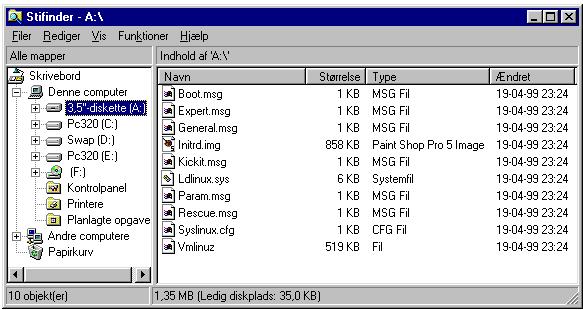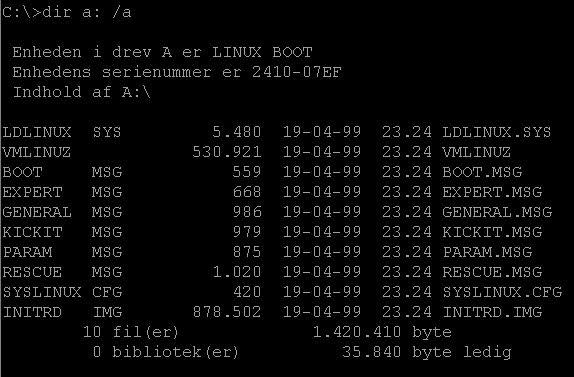|
Content by Christian Hansen (original archived HERE). Edited by Major Tom.
Last content update: 09 Feb 2001
Note: Most files linked from these pages are missing unfortunately.
Disclaimer: The information presented here is decades old and relevant only for legacy linux distros.
The first thing to do, is to check whether the distribution uses a DOS filesystem on the
install diskette, or whether the diskette is made up of something else.
If the distribution uses a DOS filesystem, you might on certain conditions use your regular
Dos - Windows box to do the kernel replacement.
When you have prepared an installation diskette according to the distros instructions, stick
it into the floppydrive of your running Dos - Windows box.
In case of a Windows box, open explorer, and see if it looks something like:

Or in the case of a Dos box, type DIR A: /A , and see if it looks something like:

The two examples above is from a standard Red Hat 6.0 install floppy, and tells you a number of
things:
2.1: You saw a filelist - the filesystem is readable to your Dos - Windows box.
2.2: The floppy has a bootloader, identified as LDLINUX.SYS. The kernel can be identified as
VMLINUZ. The installation program can be identified as INITRD.IMG.
2.3: #2.1 and #2.2 combined, means you can use your Dos - Windows box as is, to replace the
kernel on your installation diskette. Simply by drag-and-drop, or by COPY [source] A:\VMLINUZ
2.4: VMLINUZ takes up 530.921 bytes, and there is 35.840 bytes of empty space. This means, you
can go for a replacement kernel up to approx 565KB.
If you got #2.1, a diskette readable for Dos - Windows; and #2.2, you can identify a bootloader
(somename.sys) - you can skip the rest of this page, proceed choosing
a kernel, copy the replacement kernel to the diskette using windows drag-and-drop or Dos COPY,
and then begin installation. The reasoning behind this scheme is, that the separate
bootloader is in place in the bootsector, and is untouched by the copy process.
If Windows asked you to format the diskette, or DOS mourned - that is you couldn't get a
filelist - the diskette is most likely in a Linux flavored filesystem. It could be minix,
or ext2, and you couldn't care less, because none of it would ever show up in explorer or a
Dos DIR, and drag-and-drop or Dos COPY would not work either. You have to do it in a more
complicated way, involving access to a running linux system.
If you could get a filelist, indicating you have a Dos filesystem, but you have no
separate bootloader such as Ldlinux.sys, or anything else *.sys, you can not rely on the
regular Dos or Windows copy functions, to make the kernel replacement correctly. This is
because the diskette most likely boots directly from the kernel. In this case the replacement
of the kernel requires, that you can drop the kernel file exactly from the diskettes sector 0,
cylinder 0, aka the boot sector. The regular Windows - Dos copy functions do not ensure that, and you must either
have access to a special utility, or do the replacement from a running linux system.
You might think you are in a catch 22 situation, if you need to have access to a running
linux system, in order to fix your installation diskette. In a way you are, but don't worry -
we can fix that later. For now, proceed choosing a kernel.
|